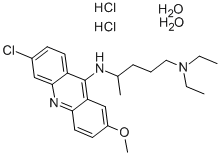SAFETY INFORMATION
| Signal word | Warning |
|---|---|
| Pictogram(s) |
 Exclamation Mark Irritant GHS07 |
| GHS Hazard Statements |
H302:Acute toxicity,oral H315:Skin corrosion/irritation H319:Serious eye damage/eye irritation H335:Specific target organ toxicity, single exposure;Respiratory tract irritation |
| Precautionary Statement Codes |
P261:Avoid breathing dust/fume/gas/mist/vapours/spray. P305+P351+P338:IF IN EYES: Rinse cautiously with water for several minutes. Remove contact lenses, if present and easy to do. Continuerinsing. |
COMPUTED DESCRIPTORS
| Molecular Weight | 508.9 g/mol |
|---|---|
| Hydrogen Bond Donor Count | 5 |
| Hydrogen Bond Acceptor Count | 6 |
| Rotatable Bond Count | 9 |
| Exact Mass | 507.182225 g/mol |
| Monoisotopic Mass | 507.182225 g/mol |
| Topological Polar Surface Area | 39.4 Ų |
| Heavy Atom Count | 32 |
| Formal Charge | 0 |
| Complexity | 461 |
| Isotope Atom Count | 0 |
| Defined Atom Stereocenter Count | 0 |
| Undefined Atom Stereocenter Count | 1 |
| Defined Bond Stereocenter Count | 0 |
| Undefined Bond Stereocenter Count | 0 |
| Covalently-Bonded Unit Count | 5 |
| Compound Is Canonicalized | Yes |
PRODUCT INTRODUCTION
description
Quinacrine Hydrochloride is the dihydrochloride salt of the 9-aminoacridine derivative quinacrine with potential antineoplastic and antiparasitic activities. Quinacrine may inhibit the transcription and activity of both basal and inducible nuclear factor-kappaB (NF-kappaB), which may result in the induction of tumor suppressor p53 transcription, the restoration of p53-dependent apoptotic pathways, and tumor cell apoptosis. Continuous NF-kappaB signaling, present in many tumors and in chronic inflammatory processes, promotes the expression of antiapoptotic proteins and cytokines while downregulating the expression of proapoptotic proteins, such as p53.
